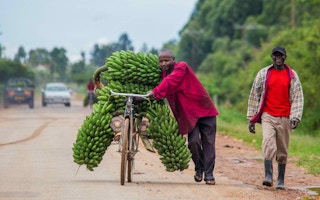Managing urbanisation sustainably poses new challenges and opportunities to recast food and agriculture systems in ways that benefit both cities and the countryside, according to a new report presented by the International Food Policy Research Institute (IFPRI) and FAO.
Meeting the rising urban demand for food can increase the incomes of the rural poor, most of whom derive their livelihoods from small and family farm agriculture, said FAO Director-General José Graziano da Silva.
“This could generate much-needed employment and development prospects for the people who will remain in the countryside of developing countries while also making healthier food easier to access in cities.”
“But growing urban demand will not automatically benefit small farmers, so we must look for solutions that can seize on the opportunities, and avoid the downside of increasing urbanisation,” he added, noting the pressure the expected changes will put on nutritional needs, scarce natural resources, employment and income, migration and a host of other critical factors.
“
But growing urban demand will not automatically benefit small farmers, so we must look for solutions that can seize on the opportunities, and avoid the downside of increasing urbanisation.
José Graziano da Silva, director-general, UN FAO
IFPRI’s Global Food Policy Report, to which FAO contributed the lead chapter, addresses a wide range of issues linked to urbanisation.
Growing urban populations will be especially visible in Africa, as a majority of the continent’s fast-growing population will be living in cities by 2030.
Globally, some 2.5 billion more people will be living in urban areas than do today. Africa and Asia will account for 90 per cent of the increase.
“The urban poor are more vulnerable than their rural counterparts are to fluctuations in food prices and devote a higher share of their household budgets to food purchases than rural populations”, said IFPRI Director-General Shenggen Fan, Director-General of IFPRI, a non-profit research institute that is part of the CGIAR network.
Rebuild the value chain
One way to encourage mutually beneficial developments for urban and rural areas alike is to develop value chains and make food systems that are more efficient and inclusive, the report says. said Graziano da Silva.
Better roads, reliable and extensive electrification, refrigerated transportation and better storage facilities are all key to making that happen, Graziano da Silva said, noting that such transformation would also lead farmers to grow higher-value and more nutritious produce, which is essential for the proper nutrition of growing urban populations.
Quality concerns over locally produced food by urban residents in many developing countries often result in greater preference for imported varieties, according to the report.
Better vertical integration of the domestic food value chain - requiring improved processing, milling, cleaning, marketing, bagging, branding and possibly even supermarkets - could remedy that. Such an effort would produce a host of agribusiness jobs and enhance the agricultural sector’s ability to make productivity-boosting investments.
The report shows how farmers benefit more when non-farm activities are developed close to their holdings. For that reason, fostering the role of intermediate towns, which can play a catalysing role in mediating the urban-rural nexus, should be a key consideration for policy makers, according to the report.
It cites evidence that the vicinity of smaller towns tend to provide smallholder farmers with greater opportunities to market their products and share in the gains from economic growth.
Smaller towns also offer migration destinations that more likely help the rural poor escape from poverty than big cities do.
“Intermediate cities can be, and most of the time are, the effective promoter of rural development,” Graziano da Silva said. Strong rural-urban linkages also allow migrants to keep stronger ties with their family networks, whereas when the ties are broken both rural and urban areas suffer.
A quiet revolution is taking place
The report looked at rural-urban value chains bringing major staple crops - potato, rice and teff - to cities in Bangladesh, China, India, and Ethiopia and found a “quiet revolution” is taking place.
Farmers are using new inputs, and in many cases preferring higher-quality varieties over higher-yielding ones to respond to demand from urban consumers willing to pay premium prices.
New techniques are proliferating in the post-farmgate segment of the value chain, such as large cold storage operations used by small farmers in India and Bangladesh - use of which is also supporting local credit systems and allowing farmers to access improved seeds and inputs, or the rapid emergence of packaged and branded rice in China.
In short, building better rural infrastructure pays off for farmers and city dwellers alike.










